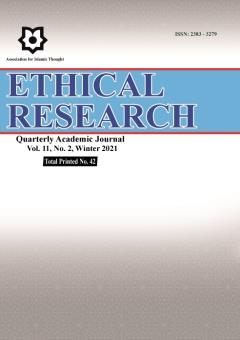Designing a Research Quality Improvement Model in Iranian Higher Education System
Subject Areas : Ethics and Islamic EducationFahimeh Talebi 1 , Hossein Ali Jahed 2 , nahid sarikhani 3
1 -
2 -
3 -
Keywords: Higher Education, Research Quality, Faculty. ,
Abstract :
The purpose of this article is to determine the components and indicators of research quality improvement in Iranian higher education system. This study, using qualitative research approach and thematic analysis, has studied the components and indicators of research quality improvement in Iranian higher education system. The statistical population of this study consisted of experts, experts and faculty members who were selected through purposeful sampling from 12 members. In-depth interviews were used for data collection and thematic analysis techniques were used to analyze the data. The validity of the research findings was ensured by member review methods, peer review, and participatory research. Also, in order to evaluate the reliability of the coded data, test-retest reliability and in-subject agreement were used. Findings showed that dimensions and components of research quality improvement in Iranian higher education system (organizational supervision, physical equipment, expert researchers, up-to-date resources, clear goals, organizational support, applicability of research and promotion of educational centers) are indicators. Promoting research includes training a researcher, preventing academic theft, reforming university structures and laws, observing justice, and addressing needs.
Abtahi, Seyyed Hossein and Torabian, Mohsen (2010). Assessment of Higher Education Goals Based on Twenty Year Country Vision Document Using Analytical Hierarchy Process (Ahp) Method, Quarterly Journal of Educational Systems, Volume 4, Number 8: 60-31 . .[in Persian]
Bagheri Majd, Ruhollah Ghavavandi, Hassan Miraghaee, Ali Abbas; Sedghi Bukani, Nasser and Bagheri Majd, Amin (2013). Analysis of Humanities Research Gap in Higher Education, Journal of Research in School and Virtual Learning, Volume 1, Number 3: 90-79. .[in Persian]
Danayee fard, Hassan (2009). An Analysis of the Barriers to Creating Knowledge in the Humanities: Guidelines for Improving the Capacity of Iran's National Science Policy, Science and Technology Policy, Volume Two, Number One: 16-1. .[in Persian]
Eslami, Zahra; Hakimzadeh, Rezvan; Sabouri, Ali Akbar (2019). A Comparative Study of Explaining Research Quality Assessment Frameworks in Iranian Higher Education System with Leading Countries in the World such as England, Australia, Netherlands, Italy and Hong Kong, Journal of Research in Educational Systems, Volume 12, Number 42: 1-1. .[in Persian]
Heyeres, M., Tsey, K., Yang, Y., Yan, L., & Jiang, H. (2019). The characteristics and reporting quality of research impact case studies: A systematic review. Evaluation and program planning, 73, 10-23.
Jafari Tehrani, Peyman-Dovlat, Hassan and Karimi, Farzad (2016). Pathology of Higher Education System in Research Using Topsis Multi-Criteria Decision Making Technique, Journal of Marine Science Education, No. 6: 78-65. .[in Persian]
Karimian, Zahra; Sabaghian, Zahra and Sadeghpour, Bahram Saleh (2011). Investigating the Obstacles and Challenges of Research and Production of Science in Medical Sciences Universities, Iranian Journal of Higher Education, Volume 3, Number 4: 22-12. .[in Persian]
Khan, M. A. (2014). Students’ Passion for Grades in Higher Education Institutions in Pakistan. Procedia-Social and Behavioral Sciences, 112, 702-709.
Norouzi, Abbas Ali; Abolghasemi, Mohammad and Ghahramani, Mohammad (2015). Investigating Barriers to Science Production from the Viewpoints of Faculty Members of Shahid Beheshti University, A New Approach in Educational Management, Journal 6, No. 2,: 77- 108. .[in Persian]
Qomi, Mohammad Reza; Rahmani, Morteza and Khakzar, Morteza (1396). Evaluating the Research Performance of a State University Using Hierarchical Analysis and Network Data Envelopment Analysis, Journal of Military Management, Volume 17, Number 67: 147-171. .[in Persian]
Rezaei, Mina and Norouzi Chakli, Abdolreza (2015). Identification and Validation of Research Productivity Indicators of Iranian Universities, Journal of Academic Library and Information Research, Volume 49, Number 2: 237-213. .[in Persian]
Rubbia, G., Franco, C., Pellizzon, D., & Nannipieri, L. (2014). Research support services in Italian Higher Education and Research Institutions: approaches, tools and trends.
Salimi, Qasem and Hosseini, Nayra (1396). Explaining the Framework for Research Excellence: A Step Towards Presenting a Model for Research Quality Assessment in Higher Education, 65, 84-97. .[in Persian]
Schultz, J. (2008). Purpose of college: Integrative literature review. Research & Teaching in Developmental
tasdiqi, Mohammad Ali and Tasadeghi, Forough (2009). Barriers to Research and Culture Research in Higher Education, Cultural Engineering, Fourth Year, Nos. 35 and 36: 37-37. .[in Persian]
Yáñez, S., Uruburu, Á., Moreno, A., & Lumbreras, J. (2019). The sustainability report as an essential tool for the holistic and strategic vision of higher education institutions. Journal of Cleaner Production, 207, 57-66.
Ziyari, Abbas; Ghods, Ali Asghar; Rashidipour, Ali; Bozorgi, Hossein and Babamohammadi, Hassan (2016). Explaining Factors Affecting Research from the Faculty Viewpoint: A Qualitative Study in Semnan University of Medical Sciences, Koomesh Journal, Volume 19, Number 1: 35-22. .[in Persian].


